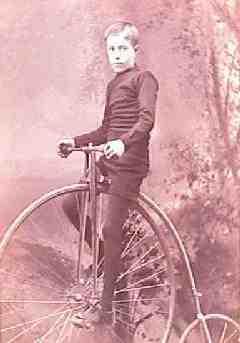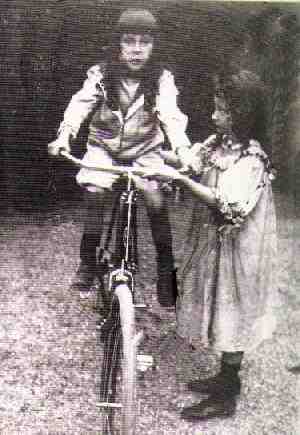
Boys Clothing Worn with Bicycles and Tricycles

Figure 1.--The highwheel bikes that appeared in the 1870s were not sutiable for children. It was not until the saftey bike was developed that younger boys began biking. This boys wears shorts with tights with his bike. While this is a studio shot, it probably reflects the costume he wore when biking.
|
Bikes were originally developed for adults, but by the late-19th century versions appeared for children. Boys in particular liked to be photographed with their bikes. Thus many photographs exist of boys in casual clothes with their bikes. Early photographs, however, are staged shots, some times with the boys wearing
their sunday best suits.
Background
The bicycle is a wheeled vehicle having a tandem arrangement of the wheels with a saddle for the rider, a steering handle, and gear for propulsion by the feet. The term bicycle was first used in 1869, previously they were commonly called velocipede, a French term dating from the late 18th century.
Ancient history
Crude, two wheeled vehicles propelled by the feet have been known as early as Ptolemic Egypt. Not until the 17th century did bicycles begin to appear with any frequency. A basic knowledge of the development of
the bicycle can be helpul in dating images, especially as boys so liked to be photographes with their bikes.
The French and Germans lead the way
A French inventor, Chevalier de Sivrac, in 1690 seized upon the idea of rigidly connecting two wheels with a wooden beam. He decorated the head of the beam with the head of a beast, often
a lion. The rider sat on a cushion and propelled the machine paddling his
feet on the ground. There were no hande bars for steering which was accomplished
by dragging the feet on the griund. It was named the celerifere
Several French versions followed witgh no notable impriovements:
the accelerator (1790) and the celeripede (1810). A German,
Baron Karl von Drais, in 1816 designed a steeing device, a handle bar
which pivitoed with the front wheel, and as a result is
often referred to as the "father of the bicycle". His machine was called the draisine. French, German, British, and American inventors made minor improvenents during the early 19th centuries. English versions
were referred to as the hobby or dandy horse.
Scottish improvements
The last major step in the development of the modern bicycle occurred in Scotland. Blacksmith Kirkpatrick MacMillan in 1839 applied driving letters to a German-style draisine. This enabled the rider for the first time to propel the machine with his feet off the ground. The machine was propelled with cranks and rods.
Another Scottman, Gavin Dalzell in 1846, further improved it and the machines became known as Dalzells in Britain.

Figure 2.--Bicylicling had by the 1880s and the invention of the saftey bike become a popular family activity. This family has outfitted all of the family
with bikes, even the boy still wearing a Fauntleroy dress and curls. I wonder if he didn't find it difficult riding his bike in that outfit.
(Of course this photograph was taken in a studio, so we don't know he actually wore when riding his bike. Notice the girl in a smock-like dress who is in a kind of multi-wheeled bike.
|
The velocipede
A more recognizable modern bike
named the velocipede was introduced by French blacksmith Pierre
Lallement about 1855.
The frame and wheels were made of wood, the tires were iron, and the
peddles were attached to the hub
of the front or driver wheel, which was slightly higher than the rear
wheel. Lallement machine proved so popular that fashionable Paris society required everyone to have one.
Finally a bicycle
The fashion quickly passed to England where te machine was dubbed the bone maker. An Englishman in 1869 submitted a patent for a bicycle with steel rims and solid rubber tires. In 1870 the first all metal machine appeared. (Previous to this
metallurgy was not advanced enough to provide metal which was strong enough to make small, light parts out of.) Another Englishman, James Starkey, in 1873 produced the first ordinary, or high wheeled bicycle--the front of which could have
a dianter as much as three times that of the rear wheel. Other improvements followed with better rubber tires and wire wheel spokes. The front wheels
became larger and larger as makers realized that
the larger the wheel, the farther you could travel with one rotation of the pedals. You would purchase a wheel as large as your leg length would allow. This machine was the first one to be called a bicycle ("two wheel"). These bicycles enjoyed a great popularity among young men of means (they cost an average worker six
month's pay), with the hey-day being the decade of the 1880's. Because the rider sat so high above the
center of gravity, if the front wheel was stopped by a stone or rut in the road, or the sudden emergence of a dog, the entire apparatus rotated forward on its front axle, and the rider, with his legs trapped under the handlebars, was dropped unceremoniously on his head. Thus the term "taking a header" came into being.
The bike in 1875 could way 30 kg, about twice the weight of modern bikes. Ball bearings and nemantic tires were introduced in the 1880s. Inventors made many
additional improvements, buy Englishman H.T. Lawson in 1880 invented a rear driving saftey, or low wheekled machine about 1880 with wheels of equal size
and the pedals attached to a sprocket through gears abd a chain which applied power to the rear wheels.
The saftey bike
The saftey bicycle, wheels of equal size, was universally adopted by American manufacturs who introduced hollow steel tubing, coaster breaks, adjustable hande bars, and other imprivenents made bikes a familiar site on American streets. Cyclists lobbied for better roads. Production boomed in America and Europe. Over 1 million bikes were manufactured in America alone in 1899. Manufacturers
brought out tricycles for younger children.
The bicycle was what made the Gay Ninties gay. It was a practical investment for the working man as transportation, and gave him a much greater flexibility for leisure. Ladies, heretofore consigned to riding the heavy adult size tricycles that were only practical for taking a turn around the park, now could ride a much more versatile machine and still keep their legs covered with long skirts. The bicycle craze killed the bustle and the corset, instituted
"common-sense dressing" for women and increased their mobility considerably. In 1896 Susan B. Anthony said that "the bicycle has done more for the emancipation of women than anything else in the world."
Bicycling was so popular in the 1880s and 1890s that cyclists formed the League of American Wheelman (still in existence and now called the League of American Bicyclists). The League lobbied for better roads, literally paving the road for the automobile.
The heyday of the bike, however, was short lived. By 1909 the bicycle industry was virtually nonexistant--Anericans turing to automobiles and motorbikes. Bikes were geerally confined to messenger boys, school children, and small groups of devotees. Bicycles continued to be an important mode of transportation in several European
countries. The popularity of bicycles increased in America in the years before World War II. All Anerican boys considered getting their first two-wheel Swinn a virtual rite of passage. There has been a further increase in popularity in recent years assiociated with the fitness craze in America.
Children
The development of the saftey bike opened the way to market bikes to children. It was still a bit of a novely in the late 19th century and very expensive. By the early 20th century, however, all American boys wanted bikes. The cost of a bike, however, meant that they the only children who got them were
children from rich or at least affluent families.
I am not positive about the time-line yet, but I believe tricycles for cgildren became available for children in the 1880s. This was actually before bicycles were available. I believe this was in part because the trikes were inherently safer than bucycles, especially early bicycles. I believe that
trikes were intially built for a wider age range of children than were to use trikes after saftey bikes suitable for children appeared.
The post World War boom of the 1920s created properity in America. Wages grew. Many families purchased automobiles. The prices of bikes
fell. Bikes became within the reach of a wide range of American kids. Another key factor was the improvements which made them safe enough for children to use. Parents began purchasing bikes for their children
in large numbers.

Figure 3.--Jacques, the son of Emile Zola, is being helped by his sister to ride his bike in this turn of the century photograph. Notice his long hair and above the knee knickers.
|
One option for younger boys instead of tricycles were peddle cars. Thes are rather intersting as the photographs not only follow changing fashions in childrens clothes, but also automotive design.
Manufacturers desperate to find new customers as adults turned to automobiles, increasingly turned to children. Manufacturers, such as Mead, Sears
Roebuck, and Montgomery Ward after the First World War introduced several new models to revitalize the bike industry. Schwinn made its big splash slightly later. The popularity of bicycles increased in America in the years before World War II. All Anerican boys considered getting their first two-wheel Swinn a virtual rite of passage.
The post-World war I designs, now called "classics", featured automobile and motorcyle elements to appeal to kids who, presumably, would rather have a motor. If ever a bike needed a motor, this was it. These bikes evolved into the most glamorous, fabulous, ostentatious, heavy designs ever. It is unbelievable today that 14-year-old kids could do the tricks that we did on these 65
pound machines! They were built into the middle 50s, by which time they had taken on design elements of jet aircraft and even rockets. By the 60s, they were becoming leaner and simpler.
Girls get bikes
I am not sure when the convention of different men's and women's bikes developed, but it must have been fairly early given the voluminous dresses
women wore at the time. Now that women mostly bike in shorts and jeans, the difference
is moot, but through the 1950s, girls commonly biked in dresses and skirts.
The question then arises as to what style bikes were purchased for
boys still in dresses and kilts. Presumably the woman's style would be purchased for them.
Modern styles
Pedaling History has on display even the recent history of the bicycle in America that we are more familiar with: the "English 3-speed" of the 60s and 70s, the 10-speed derailleur bikes which were popular in the 70s (the derailleur had been invented before the turn of the century and had been in more-or-less common use in Europe since), and of course the mountain bike of right now. There are also many oddball designs that never quite made it, including the Ingo (you have to see it to be lieve it!)
There has been a further increase in popularity of biking in recent years assiociated with the fitness craze in America.
References
Pryor Dodge, The Bicycle, Flammarion, publisher, 224 pp., 341
illustrations, 1996.
Additional information
Christopher Wagner

Navigate the Boys' Historical Clothing Web Site:
[Main bike page]
[Main outdoor play page]
[Introduction]
[Activities]
[Bibliographies]
[Biographies]
[Chronology]
[Clothing styles]
[Countries]
[Contributions]
[FAQs]
[Photography]
[Boys' Clothing Home]
Navigate the Boys' Historical Clothing Web Site:
[Fauntleroy suits]
[Sailor suits]
[Sailor hats]
[Buster Brown suits]
[Eton suits]
[Rompers]
[Tunics]
[Smocks]
[Dresses]
[Pinafores]
Created: May 12, 1999
Last updated: May 12, 1999




